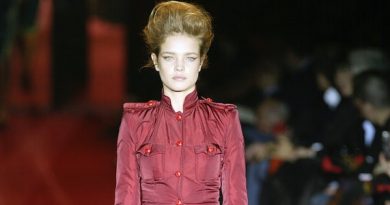Leo Narducci, Who Helped Define ‘Young Designer’ Sportswear Dies – WWD
Leo Narducci, a leading Seventh Avenue designer in the 1960s and 1970s who helped to define affordable American sportswear as a business unto itself, died Saturday at age 91.
The designer died of pancreatic cancer at a hospice care facility in Providence, R.I., according to Lannie Diamond, whose late father Edward was Narducci’s longtime partner.
Funeral services are being planned for Narducci in Brockton, Mass., and burial services will be held in nearby Randolph, where Narducci will be interred beside his late longtime partner Ed Diamond.
Narducci was born and raised in Brockton, a gritty mill city that was once an epicenter of the shoe and textile industries. By his own account, he was fascinated by fashion from the time he was a child. Narducci literally grew up in the apparel industry — his father Leo Narducci, Sr., and his mother Mary ran a contract garment factory specializing in dresses. He recalled in a 2013 interview how his father told him at 13 or 14 that he didn’t have to work summers there, and his mother had replied, “’Leave him alone, he likes it.’ And I did, I learned a great deal. By the time I was at RISD, [the Rhode Island School of Design] I could already sew. I joke that I could run a sewing machine before I could write my name, but it’s almost true.”
Before college he enlisted in the U.S. Air Force “to serve his country” as a pilot during the Korean War. Narducci returned to his main interest upon returning to civilian life. He studied fashion design at RISD, and after earning his diploma in 1960 he relocated to New York. Loomtags Inc.’s Albert Schoenfeld mentored him in fashion and marketing, and how to navigate the fickle industry with humbleness and kindness. An inveterate sketcher throughout his life, Narducci set up his first office on the 27th floor of 530 Seventh Ave., which was abuzz with activity at that time. In 1965, Narducci won the prestigious Coty Award, an honor that is comparable to today’s Council of Fashion Designers of America awards. Having helped pioneer the Young Designer category, he once explained that stores started that department because they didn’t know where to put his clothes. The other young designers and Narducci “opened the door for future young designers,” he said.
Designer Stan Herman on Saturday described Narducci as his “design soulmate,” having grown up together with fellow designers Don Simonelli, Gayle Kirkpatrick, Liz Claiborne and others. “That movement – that you didn’t have to spend a fortune on your clothes – was very novel. One of our strengths was we were designing clothes that people could afford and still looked like they were high fashion. That was unheard of at that time,” Herman said.
Clean and sparing in his designs, Narducci’s strength was easy silhouettes and prints. Having remained friends with Narducci, Herman said they shared updates on their memoirs. Plans for Narducci’s are expected to go forward, Diamond said. Herman speculated that Narducci would want to be remembered as “a true professional. He loved the garment business. He grew up in it and designed until the very end of his life. He worked his a— off. He liked publicity but he was a real worker.”
Narducci delved into licensing, private label, jewelry, lingerie, accessories, travel bags and corporate uniforms, including a contract with National Car Rental. His boldly printed designs routinely appeared in window displays at Lord & Taylor’s flagship store on Fifth Avenue, during the prime of his career.
He proceeded at a measured pace though. Narducci once said, “It’s important for the artist to realize what they do has responsibility and integrity and mustn’t lose that. I didn’t want to put my name on every darn thing people asked me to. It’s probably why my 10 minutes of fame didn’t turn into an hour. I keep my focus on what I do.”
His design company was still operating at the time of his death, and will now probably be dissolved, according to Diamond. Highly organized in maintaining his archives, some of his creations can be found at his alma mater RISD, as well as at Lasell University outside of Boston The designer remained connected to his alma mater by hiring RISD students as interns and pitching in at the Providence campus from time to time. About a decade ago he blended his affinity for manufacturing and his college town, by moving into the former Browne & Sharpe Manufacturing factory in Providence that had been converted into residential housing.
Patti Cappalli, a RISD classmate, remembered Saturday how Narducci was “the glamour guy” of the class, who already knew the ins and out of pattern making and sewing. “Everyone was in awe of Leo. He was older and a veteran from being in the Air Force.” she said. “He had an outsized personality and was very generous. I can’t say enough good things about him.”
A few years after graduating, Narducci called Cappalli encouraging her to interview for a job that he had recently turned down but thought she would be perfect for. He turned out to be right and Cappalli wound up accepting the job and moved to New York. Decades later the pair worked together briefly on a private label program.
The way he saw it “Fashion comes and goes, and a person’s style extracts from that. People who are too into fashion end up being too cartoony. People with style take from fashion and add it to their style. And they usually mix things up.”
In 1966, Narducci first met Diamond, a Coty Award winner for textiles, at a fashion event, a moment that started what would be a 25-year professional and personal union, according to Diamond’s daughter. The bulk of that time was spent at 63 East 9th St., as well as more relaxing times at the Fire Island home they owned for a while. During those Fire Island days, designer Jeffrey Banks recalled meeting Narducci, “a very good commercial designer in dresses ands sportswear, when sportswear was starting to take off in the late 1960s.”
Coming up along with Herman, Anne Klein and others, Narducci distinguished himself by listening to buyers, “which a lot of designers don’t do because of their egos,” Banks said. “But he did and he turned out year after year very commercial clothes, which is no small feat.”
Leo Narducci
Photo Courtesy
Narducci and Diamond then bought and built country homes in Stone Ridge, N.Y. over a period of years, and opened an antiques business at one point as a side business. They routinely collaborated, with Narducci choosing the theme of textiles and Diamond developing it. After Diamond was diagnosed with amyloidosis, a rare disease that was then little-known, the couple moved to Brockton to live with Narducci’s mother, who helped care for Diamond. After Diamond’s death, the designer relocated to his home city permanently.
Interested in all the arts, especially theater and music, Narducci’s actress friend Kate Davis often wore his designs. The designer had his own star moment. When Warner Bros. was making the movie “Mame” starring Lucille Ball, he was tapped by Trevira, a German textile company, to create a 16-piece collection inspired by the film. The collection debuted with a show at The Plaza, which coincided with the opening of the movie in March 1974.
The collection had strong sales and Narducci made personal appearances at Bloomingdale’s, Filene’s in Boston; I. Magnin in San Francisco, and Liberty House in Honolulu. His post-show introduction to Ball also was a hit. He described how it played out, “They kept moving me around. ‘As soon as Lucy comes in, you’ll be the first person she talks to,’ they assured me. They kept moving me around. And around. It was starting to get a little boring, and then … ‘Here she comes!’ Before I knew it, I was talking to Lucille Ball. I couldn’t believe it.”
Nor could his mother nor anyone else in his hometown, when an Associated Press wire photo of that exchange landed on the front page of the Brockton Enterprise.
Having worked for Narducci in the 1970s and remained friends, designer Ellen Raines Martin said Saturday, “He was truly one of the most creative people around. But he also let you be you. You were allowed to create. It was not like somebody gave you directions. He wanted you to grow. He was like that with anyone, who worked with him over the years.”
Above all, Narducci listened. “Most importantly, he was interested in others. Whether being a critic at Parsons or RISD, he listened to others. He never was critical. He always acknowledged, who the person was on their creative level. Sometimes in life, people can’t have another creative person. He welcomed creativity, but [he was] always interested,” Martin said.
She added, “He was real. He never departed from who he was. It is a gift.”
As for how Narducci would have liked people to remember him, Cappalli said, “I would like to say ‘as a wonderful women’s wear designer,’ but I don’t think that would be it. I think he would like to be remembered for being kind, generous and a friend to everyone.”
Always working, Narducci never lost his drive. He observed about a decade ago, “The greatest surprise for me has been the longevity of everything I’ve done and [am] still doing. I don’t think in the past, but I think about tomorrow. I think about the future. It’s strange considering my age. I get up every morning and I never stop. And I say, ‘I wish…I wanted to…Why didn’t I?’ I think, ‘What do I want to do tomorrow and the next day and the next?’”
In addition to Lannie Diamond, Narducci is survived by his husband, Robert Ferrari.




